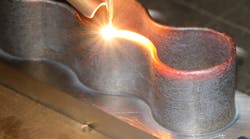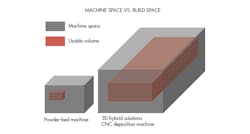Hybrid Printing Could Leave Powder-Bed 3D Printing in the Dust
3D-printing metal in the deposition style carries many names, such as laser-engineered shaping, directed energy deposition, and laser metal deposition. Because these all represent the same concept, this article will refer to it simply as deposition.
The two main types of metal 3D printing are deposition and powder bed. Deposition has been around for centuries, with massive amounts of data supporting the pseudo welding process. Both deposition and powder bed have their associated pros and cons; however, adding CNC machining to deposition reduces many of those cons.
One should have a good working knowledge of several factors when considering 3D printing with metal:
• Size of parts
• Printing speed
• Product-development cycle time
• Design and material freedom
• Safety
Size of Parts
Where is metal AM going? Well, it’s going BIG! A review of the size of the different providers of powder-bed metal 3D printers will tell you that your parts must fit into an average size of 1 cubic foot, about the size of a microwave oven. Due to overwhelming demand, hybrid solutions can retrofit to large five-axis CNC machines to bring deposition style into the big AM market.
With deposition-style AM (commonly fitted to CNC machines), you’re only limited to the size of the motion system or CNC machine you’re working on. AM is also a minimal waste process—some large machining applications require you to mill/turn thousands of dollars of material away to leave a near net shape part.
For example, large structural components in aerospace, large mold applications in aerospace and automotive, and large fixturing tools in industrial and manufacturing industries are common reasons why customers are switching to AM and hybrid processes. The hybrid process uses AM to build the part, then finishes it with a traditional milling/turning process so that there is minimal waste while maintaining the same tolerances of your CNC mill/lathe.
Build Volume and Floor Space
Another important point to consider in a world where we’re constantly strapped for space, is the usable printing space to machine floor space ratio. For example, M2 from Concept laser, a typical-sized powder-bed machine, has about a 0.6 ft.3 build space, and a 49.6 ft.2 floor space. In some of the new hybrid platforms, we have seen applications under development that have 9600 ft.3 feet of workable space to 430 ft.2 of floor space. That’s a 15,238X increase of workable space for only 8.3X the shop floor space!
In terms of machine volume, retrofitting a deposition head to the CNC machine offers a larger build space.
Printing Speed
Powder-bed and deposition technologies vary greatly in terms of printing speed. Deposition can be over 125X faster than powder bed. Powder bed’s aim is to achieve fine surface texture; thus, it requires a slider to carefully and slowly bring out a new layer every 10 to 25 microns, leaving it at a slow speed of around 0.08 lbs per hour.
On the other hand, deposition is a process that lays down material with large beads reaching 10-mm-plus in width and 2-mm-plus in height. Rates of over 10 pounds per hour or more are very achievable. 3D Hybrid Solutions is working on high-speed deposition that, we believe, could catapult that rate up to 10X faster.
Product-Development Cycle Time
One of the most valuable applications for metal additive manufacturing is shortening the product-development cycle time. For many industries, such as the space race, it is incredibly important to be there first. If you can reduce the manufacturing time, you can iterate through the design-manufacture-test process very quickly.
Both metal AM processes are helping this become a reality, but hybrid deposition has a few secret weapons. Beyond the amazing speed and subtractive capability, the ability to launch new designs with multiple materials and internal features are playing a role as a springboard to the development process. Parts that might have high stressed areas, but are also limited by a property of mass of conductivity, can use this new secret weapon to put the extra “factor of safety” specifically where it is needed.
Design and Material Freedom
Design freedom is one of the major benefits to printer technologies, but hybrid deposition takes it to a whole new level. Deposition in a five-axis machine allows you to put strong material where it is needed. Or, in a heat-transfer application, it allows you to place conductive material where it is required all on the same part with complete metallurgical bonds. All of this, mixed with the freedom to print internal features and complex geometries offered by AM, is why this technology is seeing such quick adoption. Aerospace customers can’t ignore the potential benefits.
AM with powder: Retrofitting a metal-deposition 3D-printing process to a five-axis CNC mill/lathe enables multiple features to be printed on different axes in a single print.(Source: Laserline Gmbh, Germany)
At one point during my time as a student design engineer, I was designing a special tooling for engine remanufacturing. I will never forget, after all the work of getting the design together, being told “that will cost a million dollars to make!” This was before metal 3D printing/additive manufacturing came along and allowed us more flexibility with part geometries.
Now, with both powder-bed and deposition-style printing, we are able to open that bottleneck up to yield almost limitless design. Sometimes these two AM technologies can even work together. If a part is powder-bed printed, it can be cleaned up in a hybrid machine. It is possible to machine and apply metal coatings and features that otherwise wouldn’t fit into a powder-bed machine.
The most common questions customers ask about AM processes concern the material properties. Generally, when raw, they're between a casting and a forging. Post-processing can bring them to heat-treated AMS and ASTM standards. But, the secret weapon of deposition-style technology is the ability to have control over the material properties throughout the build. You can even switch materials to place stronger materials in areas of high stress and lighter materials in areas of lower stress.
AM with wire: Internal features can be milled while the part is being printed, as the machine can switch from additive to subtractive and back as easily as switching tools. (Source: Laserline Gmbh, Germany)
Deposition-style printing is giving us the ultimate freedom, switching metals on command. With deposition-style printing, designers can go back to the drawing board and redesign with almost no limitation, specifying gradient material properties and different materials in different areas.
Safety
Safety with metal powder feedstock is gaining attention due to certain hazardous conditons. It is possible for the fine particulate metal in the powder-bed process to combust or explode. Powder-bed-style printers use a fine metal powder, down to about 15 microns, whereas deposition AM uses metal sand (sometimes wire) that is an average size of 100 microns.
Data from the U.S. Department of Interior shows titanium can explode if the particulate is as small as needed for powder bed. One of our supplier’s suggests that at about 50 microns, Titanium 6al4v may no longer be at risk of combustion. The important factor is particulate size. Size has the same affect for other materials like aluminum and other reactive materials. You don't hear about aluminum cylinder blocks exploding in cars.
Inhaling metal power is also a health concern. Powder-bed systems are commonly equipped with ventilation controls and proper PPE to control the inhalation hazard. Inhaling metals is a common, if not obvious, concern. Finer powder is more likely to be left aloft in the air versus the heavy sand from the deposition process.
Equipment Cost
Another important consideration when entering the additive-manufacturing market is the required investment. Powder-bed machines are no stranger to the $1M price tag. Alternatively, a deposition machine is able to be retrofitted to nearly any existing CNC machine. Some packages costing as little as $200k. Most other off-the-shelf hybrid machines complete with a CNC are pushing $1.5-$2M.
Wire Electron-Beam AM vs. Deposition Technology
The major differences between electron-beam and laser-deposition technology are the former’s huge cost and reduced versatility. Both laser deposition and electron beam can process titanium safely with the right options. Electron-beam sources can be bulky, and are pricier than laser sources. Electron beam requires a large vacuum chamber to operate in, which virtually eliminates the option to integrate to a CNC machine. Laser deposition has the improved versatility to be integrated to a very large machine with minimal extra costs.
Karl Hranka is the founder of 3D Hybrid Solutions Inc., a new metal additive-manufacturing (AM) tool supplier that focuses on turning CNC machines into hybrid (additive-subtractive) machines.




